 I normally hate memory foam style insoles. In fact, I once included them in a list of running shoe design elements that drive me nuts. My usual experience is that they rob the foot of ground feel, but to date I’ve only encountered this type of insole in shoes that already have fairly significant midsole cushioning. The Mizuno Wave Evo Ferus has changed my mind a bit on the squishy sockliner, and it’s a welcome addition to what has been a surprisingly fun shoe to run in.
I normally hate memory foam style insoles. In fact, I once included them in a list of running shoe design elements that drive me nuts. My usual experience is that they rob the foot of ground feel, but to date I’ve only encountered this type of insole in shoes that already have fairly significant midsole cushioning. The Mizuno Wave Evo Ferus has changed my mind a bit on the squishy sockliner, and it’s a welcome addition to what has been a surprisingly fun shoe to run in.
I received a review pair of the Mizuno Ferus from Runningshoes.com about a month ago (Disclosure: these were provided free of charge for review purposes). Given that I had previously worn a size 10 in the Mizuno Cursoris, I asked Runningshoes.com to send me the same size. I figured that the same size should work for another shoe in the Mizuno Evo collection. I was wrong. The first pair of Ferus that I received fit huge! There was no way I was going to attempt running in them. So, they were sent back in exchange for a 9.5. I can’t remember ever having dropped down to a 9.5 in any shoe (I more often size up to 10.5), but the new pair fit great and off I went.
For my first run in the Ferus I decided to head out on a hilly route to my daughter’s school. I was wary of the memory foam sockliner, but the route was all on asphalt road so I though a bit of softness might be warranted – I opted to leave them in. It was also an unseasonably hot day, and since the shoes felt good walking around sockless, I decided to run the 5.5 miles sans socks. Big mistake. There was blood, much blood:
On the plus side, the shoes performed great. My initial concern over the sockliner was unwarranted – it turns out that a thin memory foam sockliner paired with a thin, firm, zero drop sole (14mm heel, 14mm forefoot) makes for a great ride on the road. Just enough softness to take the edge off. And, if you want a firmer ride with good ground feel you can just take the insole out or swap it with something thinner and firmer.
Now, I should point out the obvious – the Mizuno Ferus is a trail shoe. However, though it has a luggy sole, the lugs are low and flat and this shoe works perfectly well on asphalt and cement surfaces. In fact, most of the 30 or so miles I have put on them so far were on roads, with only 2-3 miles total running on trail and crushed rock. I did also hike up and down Mt. Pisgah in VT in them, and so far traction and rock protection has been fine.
Since I’m mostly a road runner with the occasional mile stretch of trail included on some of my frequent routes, I value a shoe that can handle multiple surfaces well. The Mizuno Ferus fits that bill perfectly. In fact, I’d go so far as to say that I think this shoe might be a better choice than the Mizuno Cursoris for road running given durability concerns about the sole of the latter. The Ferus sole is more amply covered by rubber, and wear on my pair is minimal so far despite the road miles.
The upper of the Ferus is a soft, breathable mesh – very comfortable against the foot. The mesh has a bit of stretchiness to it, though not as much as the forefoot mesh of the Cursoris, and extensive welded overlays on the Ferus hold the foot well. I also like that there is a welded overlay along the margin between the sole and the upper given how prone this area is to blowing out in trail shoes. The uppers on my pair are holding up well so far.
I’ve enjoyed the Ferus so much that I’ve actually been wearing it regularly as a casual shoe. It has a very roomy, paddle-shaped toebox and this combined with the low-profile sole make it super comfortable for all day wear.
If I had to compare the Mizuno Ferus to another shoe on the market, the closest competitors would probably be the Merrell Ascend Glove and the Inov-8 Trailroc 235. All three are lightweight (Ferus is 7.9oz in men’s size 9), zero drop, have roomy toexboxes, provide decent protection despite relatively thin soles, and all are fun to run in. I have some concerns about upper durability of the Trailroc 235, so I’d probably rank that one 3rd among the three shoes. Comparing the Ascend Glove and the Ferus, I’d say that the Ferus offers a slightly cushier ride (thanks largely to the insole) and is more comfortable on the road. The Ascend Glove forefoot has a less paddle-like appearance. Both are great shoes.
All in all I have to say that the Mizuno Ferus has been quite a pleasant surprise. If you’re in the market for a low-profile, zero drop road-to-trail shoe it’s definitely worth a look!
Oh, and about the blood – socks solved that problem on subsequent runs :)
Big thanks to Runningshoes.com for providing the sample reviewed here – you can purchase the Mizuno Ferus over at their website.
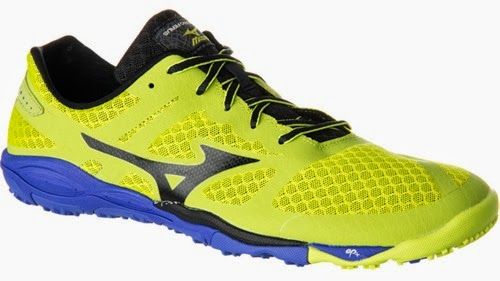
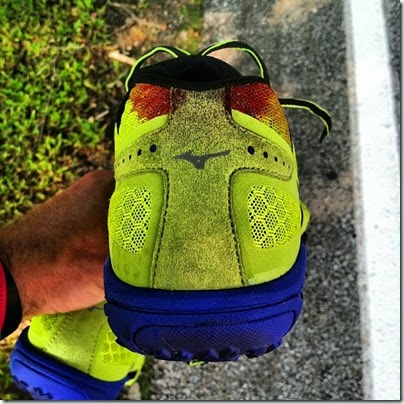

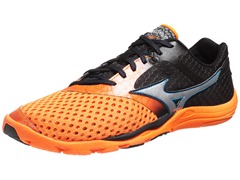
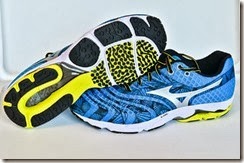
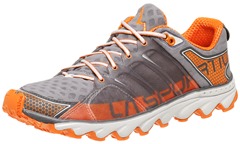
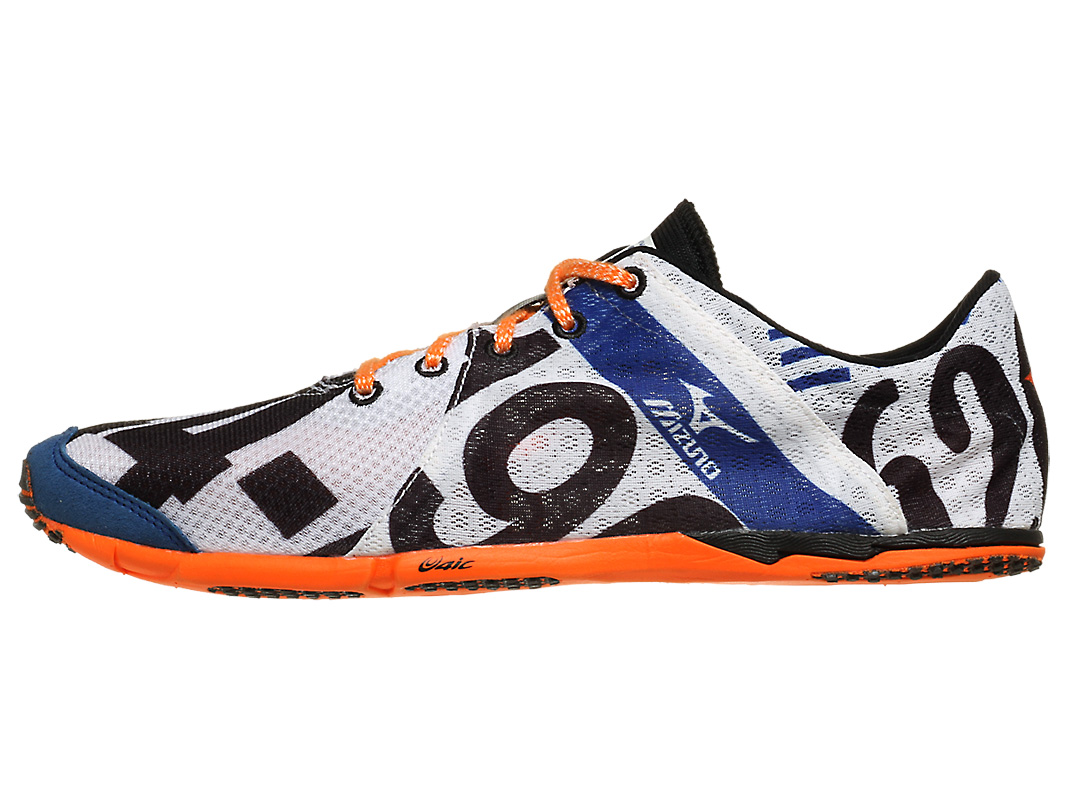
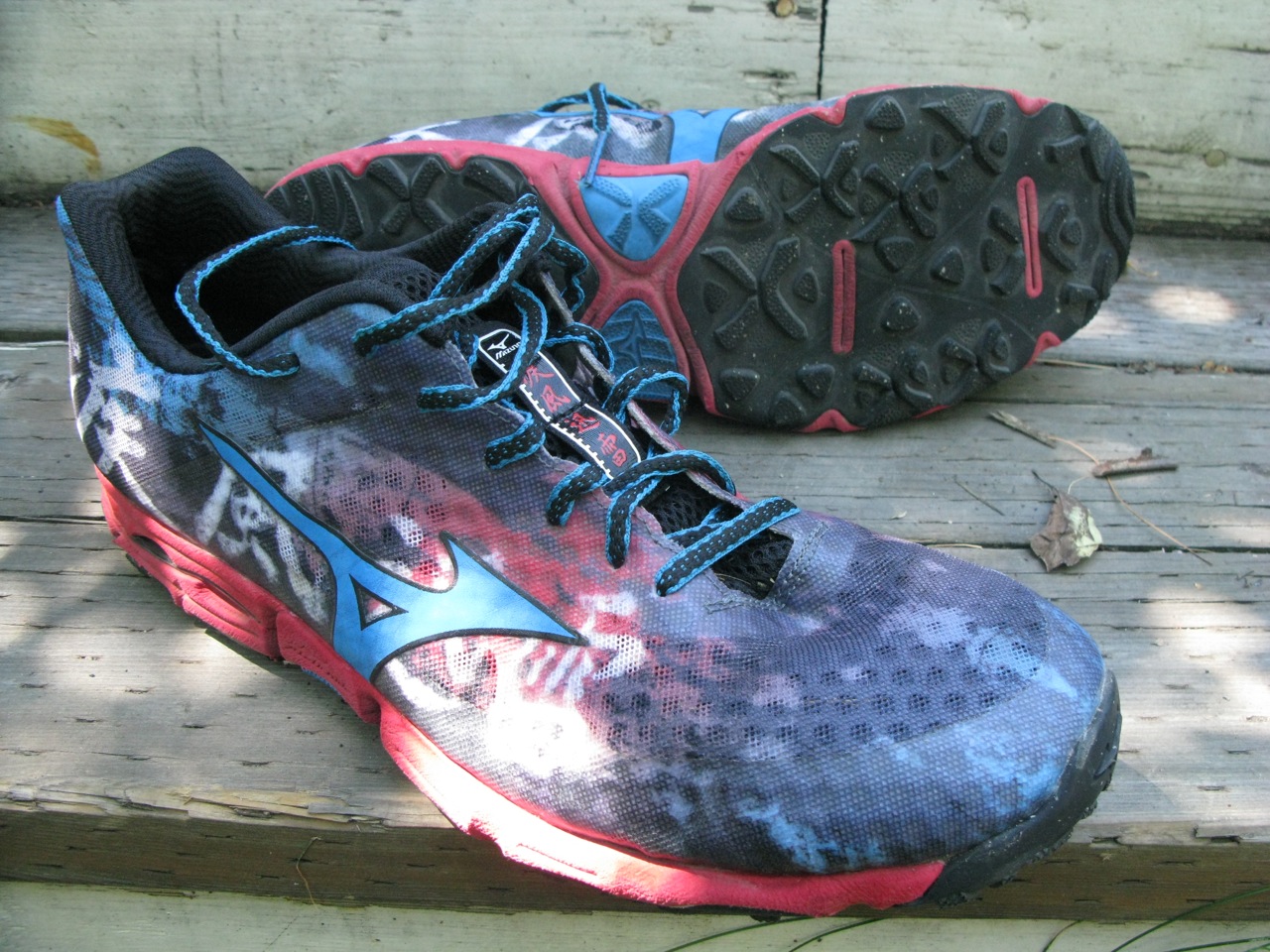














I saw the Ferus on a website and wondered what niche it was supposed to fill due to the extremely low stack height. You don’t state whether the shoe has a rock plate or how it handles in wet weather. I’d love to see an update following more trail running.
Nate has a pair too – hoping he’ll be able to share some of the more trail specific aspects. Haven’t had too much rain up here lately so no wet runs.
—-
Pete Larson’s Web Links:
-Performance Health Spine and Sport Therapy<http: about-us=”” dr-peter-larson=”” performancehealthnh.com=””>
-My book: Tread Lightly: link to ow.ly
-Blog: https://runblogger.com
-Twitter: link to twitter.com
-Facebook Page: link to facebook.com…
-Discussion Forum: https://runblogger.com/forum</http:>
Your kids don’t have a Slip and Slide to make the yard good and muddy?
The Ferus does have a rock plate, or rather a Wave plate, in the forefoot. I believe that it’s the same material Mizuno generally puts in the midfoot of their shoes to provide some stability. I ran in these on some pretty rocky sections of trail and felt protection was adequate if you are already used to a minimal trail shoe. The only issue I had with them was what I felt to be a very low toe box. I have the requisite thumb’s width of room at the end of the shoe, but with a low toe box that tapers a lot toward the front of the shoe I had issues with my big toe nails getting smashed on steep downhills.
Pete, did you have any such troubles?
Looks interesting. FWIW, I had to size down to a 9.5 on my Sayonaras and I’m usually a 10.5/11 guy. Crazy.
Pete, do you think it was a loose heel that caused the rubbing, or just the material?
I have that issue in a lot of shoes, and it was just on one side, so may just be fit on my foot.
—-
Pete Larson’s Web Links:
-Performance Health Spine and Sport Therapy<http: about-us=”” dr-peter-larson=”” performancehealthnh.com=””>
-My book: Tread Lightly: link to ow.ly
-Blog: https://runblogger.com
-Twitter: link to twitter.com
-Facebook Page: link to facebook.com…
-Discussion Forum: https://runblogger.com/forum</http:>
Gotcha. I tend to be pretty picky about rubbing on my shoes, but I’ve never had that much blood on my heels (just on insteps and toes…)!
I find it amazing how a very modest sole can be put on a shoe classed as a trail shoe. Those lugs look just a couple of mm deep, even a small muddy puddle will swamp them and lead to slippage. My F-Lite 232’s have deeper lugs but are still very modest and work great on dry trails but don’t handle mud well, so I suspect the Ferus will only fierce in the way that causes you to slip and slide and anything other than a gently rolling dry trail.
It’s fell season here in the UK so I’ve just purchased a pair of X-Talon 190’s, now they have a proper sole for serious off trail running, with deep widely spaced lugs, couldn’t be more different to the Ferus and other rather feebly lugged “trail” shoes.
I really wished shoe manufactures would put proper soles on trail shoes so that they can handle going off trail, handle a bit of mud and snow. Instead we have lots of shoes that have little more aggressive tread than you find on standard road shoes. I would love to have a bit more choice of shoes when wanting to going out on wet, muddy and snowy trails.
Inov-8 considers the X-Talon an “Off-Trail” shoe. Trail shoes and Fell shoes are very different animals.
The X-Talon is indeed a specialist “Off-Trail” shoe and very much at the extreme end of grip, but it really shouldn’t be too much to ask for a Trail shoe that can accommodate a bit of “Off-Trail” and winter conditions. A trail shoe that can only properly handle dry hard packed trails is really not much better than a road shoe.
Having yet another minimal shoe that is marketed as trail shoe but really isn’t much more than a road shoe with a slightly more aggressive sole is really not solving the problem that many of trail runners need to solve – we need grip when the going gets tough, it keeps us safe. In this respect the Ferus doesn’t cut it as a trail shoe.
Different shoe for different runners I guess. I’d virtually never need a luggy trail shoe for my running, I like trail shoes that can handle both road and trail and can provide a bit more grip than a road shoe on ice in winter. It’s probably why I’ve never reviewed anything like the X-Talon. Guess I need to seek out more mud :)
—-
Pete Larson’s Web Links:
-Performance Health Spine and Sport Therapy<http: about-us=”” dr-peter-larson=”” performancehealthnh.com=””>
-My book: Tread Lightly: link to ow.ly
-Blog: https://runblogger.com
-Twitter: link to twitter.com
-Facebook Page: link to facebook.com…
-Discussion Forum: https://runblogger.com/forum</http:>
Thanks for this review, Pete. I’ve been curious about this one.
How would you describe the fit around the midfoot, especially under the arch. I think I read something about the Cursoris having a substantial supportive element under the arch. So, I’m wondering if that exists in the Ferus.
I’m interested in getting into trail shoes and I really like Mizuno so thanks for reviewing.
No problem, it’s a solid shoe!
—-
Pete Larson’s Web Links:
-Performance Health Spine and Sport Therapy<http: about-us=”” dr-peter-larson=”” performancehealthnh.com=””>
-My book: Tread Lightly: link to ow.ly
-Blog: https://runblogger.com
-Twitter: link to twitter.com
-Facebook Page: link to facebook.com…
-Discussion Forum: https://runblogger.com/forum</http:>
It’s weird that you had to size down, because the shoefitr gives a size 10 in the Ferus for my Cursoris in 9.5. Which is consistent with all the other pairs I currently own: they all give me a size 10 for the Ferus.
I’m pretty excited about the Ferus. I suspect the overlays give it a bit of structure compared to the shapeless Cursoris and the rubber outsole must be solving the durability issue.
How would you say it compares to the Cursoris in terms of ground feel and flexibility? I found the Cursoris to be lacking in both departments. And what about the squishiness? I’m expecting the Ferus to give a firmer ride, but does it?
If the Ferus is as comfortable as the Cursoris while providing a firmer ride and better ground feel, it could be the perfect shoe.
I am currently running in Newton Gravitys and love them but I don’t like their trail shoes so much, I think their new trail shoes maybe a little “too warm” for New Mexico weather. I am looking into the mix masters and this mizunos for my short runs (60/40 road/trail), do you think this may be too drastic of a change coming from “cushy” newtons?
Thank you for all your reviews, I really enjoy them.
Yes, the current Newton BoCo AT would be really warm in your climate, but I think they are coming out with a version with a lighter upper for summer. The Mix Master is 4mm drop so would be easier on your calves compared to the Ferus.
hi~ I normally wear size 11 (2E) in mizuno.
what size do you recommend?
I went a half size down in my pair.
hi,
i am a midfoot striker. until now i have run just races up to 10k, i am a beginner. in a couple of months i am going to run my first half marathon. i expect to be around 2 hours.
i am using right now two shoes: saucony peregrine 3, and Mizuno Ferus. I run in asphalt and forest roads. i wear usually the ferus in short workouts, and use the peregrine for longer easy workouts.
actually, of both, i like the ferus the most. but I am concerned that given they had not much cushioning, my feet would end aching if i wear them in long workouts or even the halfmarathon race(which is going to be on asphalt).
can somebody give me his opinion about using the ferus for a halfmarathon?
Best way to find out is to progressively but slowly increase your distance in them on training runs. You body will let you know. We’re all different, and some people will have no problem running long in a shoe like that, others might have more trouble.
My first impressions from the Mizuno Ferus:
The good: It has a glove like fit, it is like having a sock a your foot. It has a wide toebox which allows your fingers to splay, The upper is very breathable, the sole is very soft, it feels like running on a padded gym floor as Peter wrote in the cursoris review.
The bad: Not enough traction, especially on scree. I think the sole needs a redesign. The heel is a bit loose. This shoe is for running up to 2 hours because of minimal cushioning. After that time, the ball of my foot starts having pain. I would love to see a ferus with more cushioning. Also the heel is not well protected from feeling stones. I havne’t decided yet if i will keep this shoe. I usually run3-3.5 hours and i think that the cushioning is not enough.
Having run about 50km in them, the loose heel is my main issue, especially when going downhill.
I wear this shoe since more than one year now.
I love them, good mid foot striking, good cushionning, versatile shoe : road, track workout, trail (but not with wet mud : they slip easily, I have xt190’s for that).
The bad point : they fit quite too large, I have to go one size down in these, so when ordering wia website, it is an issue as you have to send them back one or two times, etc etc etc…
Hi,
is this shoe still available? If not, is there a successor?
Greets